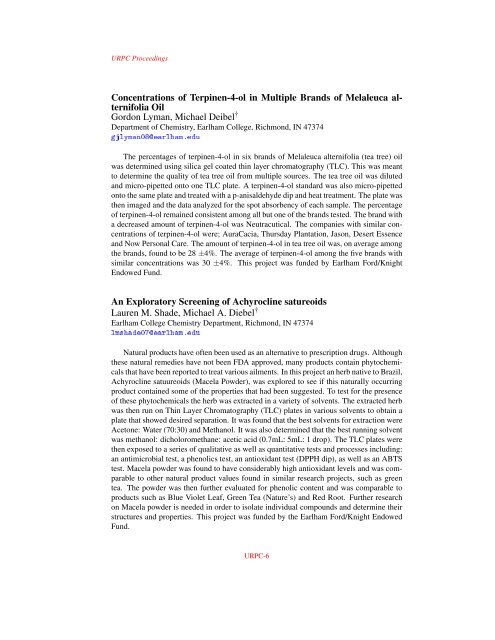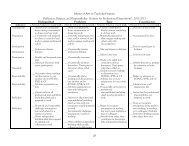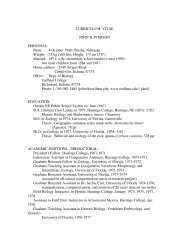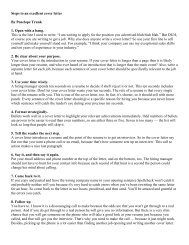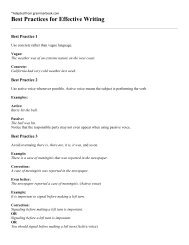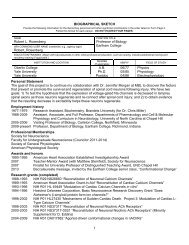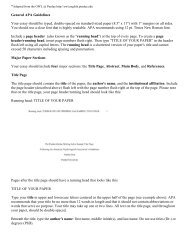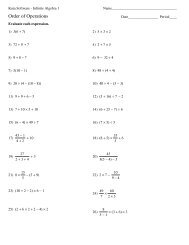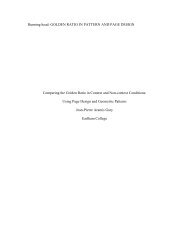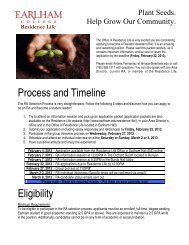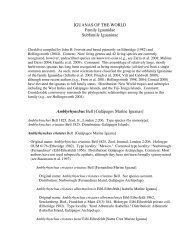Earlham College, Richmond, IN - Earlham Computer Science ...
Earlham College, Richmond, IN - Earlham Computer Science ...
Earlham College, Richmond, IN - Earlham Computer Science ...
You also want an ePaper? Increase the reach of your titles
YUMPU automatically turns print PDFs into web optimized ePapers that Google loves.
URPC Proceedings<br />
Concentrations of Terpinen-4-ol in Multiple Brands of Melaleuca alternifolia<br />
Oil<br />
Gordon Lyman, Michael Deibel †<br />
Department of Chemistry, <strong>Earlham</strong> <strong>College</strong>, <strong>Richmond</strong>, <strong>IN</strong> 47374<br />
gjlyman08@earlham.edu<br />
The percentages of terpinen-4-ol in six brands of Melaleuca alternifolia (tea tree) oil<br />
was determined using silica gel coated thin layer chromatography (TLC). This was meant<br />
to determine the quality of tea tree oil from multiple sources. The tea tree oil was diluted<br />
and micro-pipetted onto one TLC plate. A terpinen-4-ol standard was also micro-pipetted<br />
onto the same plate and treated with a p-anisaldehyde dip and heat treatment. The plate was<br />
then imaged and the data analyzed for the spot absorbency of each sample. The percentage<br />
of terpinen-4-ol remained consistent among all but one of the brands tested. The brand with<br />
a decreased amount of terpinen-4-ol was Neutracutical. The companies with similar concentrations<br />
of terpinen-4-ol were; AuraCacia, Thursday Plantation, Jason, Desert Essence<br />
and Now Personal Care. The amount of terpinen-4-ol in tea tree oil was, on average among<br />
the brands, found to be 28 ±4%. The average of terpinen-4-ol among the five brands with<br />
similar concentrations was 30 ±4%. This project was funded by <strong>Earlham</strong> Ford/Knight<br />
Endowed Fund.<br />
An Exploratory Screening of Achyrocline satureoids<br />
Lauren M. Shade, Michael A. Diebel †<br />
<strong>Earlham</strong> <strong>College</strong> Chemistry Department, <strong>Richmond</strong>, <strong>IN</strong> 47374<br />
lmshade07@earlham.edu<br />
Natural products have often been used as an alternative to prescription drugs. Although<br />
these natural remedies have not been FDA approved, many products contain phytochemicals<br />
that have been reported to treat various ailments. In this project an herb native to Brazil,<br />
Achyrocline satuureoids (Macela Powder), was explored to see if this naturally occurring<br />
product contained some of the properties that had been suggested. To test for the presence<br />
of these phytochemicals the herb was extracted in a variety of solvents. The extracted herb<br />
was then run on Thin Layer Chromatography (TLC) plates in various solvents to obtain a<br />
plate that showed desired separation. It was found that the best solvents for extraction were<br />
Acetone: Water (70:30) and Methanol. It was also determined that the best running solvent<br />
was methanol: dicholoromethane: acetic acid (0.7mL: 5mL: 1 drop). The TLC plates were<br />
then exposed to a series of qualitative as well as quantitative tests and processes including:<br />
an antimicrobial test, a phenolics test, an antioxidant test (DPPH dip), as well as an ABTS<br />
test. Macela powder was found to have considerably high antioxidant levels and was comparable<br />
to other natural product values found in similar research projects, such as green<br />
tea. The powder was then further evaluated for phenolic content and was comparable to<br />
products such as Blue Violet Leaf, Green Tea (Nature’s) and Red Root. Further research<br />
on Macela powder is needed in order to isolate individual compounds and determine their<br />
structures and properties. This project was funded by the <strong>Earlham</strong> Ford/Knight Endowed<br />
Fund.<br />
URPC-6


